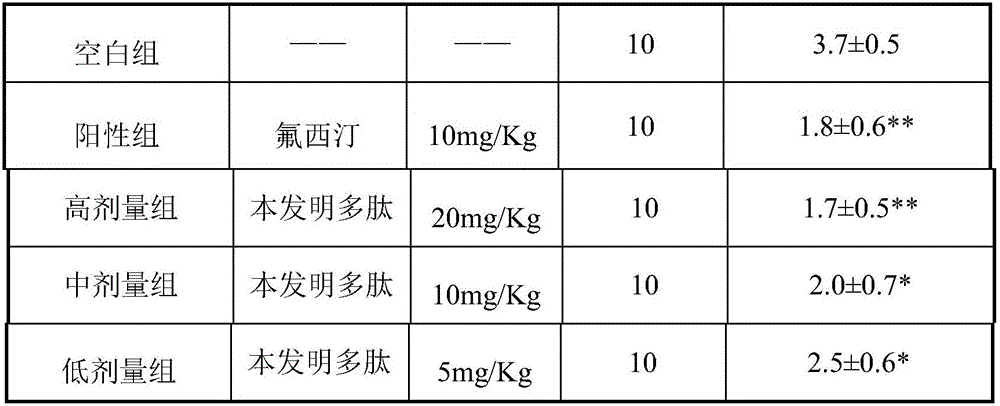N-methyl-D-aspartate (NMDA) receptor antagonist peptides and application thereof
A receptor antagonist, aspartic acid technology, applied in the field of N-methyl-D-aspartic acid receptor antagonist polypeptide, can solve problems such as untreated depression
- Summary
- Abstract
- Description
- Claims
- Application Information
AI Technical Summary
Problems solved by technology
Method used
Image
Examples
Embodiment 1
[0014] Inhibitory effect of N-methyl-D-aspartate receptor antagonist polypeptide on N-methyl-D-aspartate receptor current in rat hippocampal neurons.
[0015] The NMDA receptor currents of cultured rat hippocampal neurons were recorded by whole-cell patch technology. Hippocampal neurons were extracted and cultured from SD rat brains within 24 hours of birth, and were cultured in an incubator at 37°C and 5% CO2 for 8-13 days for patch clamp experiments.
[0016] The instrument used for the whole-cell patch clamp recording is CEZ-2400 patch clamp amplifier (Nihon Kohden, Japan), and the inner fluid composition (mmol / L) of the glass microelectrode: KCl 140, CaCl2 1, MgCl2 2, HEPES 10, EGTA 11, ATP 4, adjust pH value to 7.2 with 1M KOH, adjust osmotic pressure to 310mOsm / L with sucrose, electrode resistance 3-5MΩ. External fluid composition for perfusion (mmol / L): NaCl 150, KCl 5, CaCl2 2.5, HEPES 10, D-glucose 10, tetrodotoxin 0.0002, adjust the pH value to 7.4 with 1M NaOH, adj...
Embodiment 2
[0020] Effects of an N-methyl-D-aspartate receptor antagonist polypeptide on a mouse forced-swim stress-despair model.
[0021] Using ICR mice as the test animals, 50 mice, half male and half male, weighing 18-22g, were randomly divided into 5 groups: high-dose group, middle-dose group, low-dose group, positive control group, blank group, Each group l0. The treatment group was subcutaneously injected with the polypeptide of the present invention at doses of 20, 10, and 5 mg / Kg, the control group was given fluoxetine at a dose of 10 mg / Kg, and the blank group was given normal saline for 7 consecutive days. One hour after administration on the seventh day, the mice were subjected to a forced swimming test. The mice were forced to swim in water at 20-25°C for 6 minutes, and the immobility time within 4 minutes after recording was recorded. The time spent floating with the head out of the water is used to evaluate the effect of the polypeptide of the present invention on the mode...
Embodiment 3
[0027] Effects of an N-methyl-D-aspartate receptor antagonist polypeptide on a mouse tail-suspension stress hopelessness model.
[0028] Using ICR mice as the test animals, 50 mice, half male and half male, weighing 18-22g, were randomly divided into 5 groups: high-dose group, middle-dose group, low-dose group, positive control group, blank group, Each group l0. The treatment group was subcutaneously injected with the polypeptide of the present invention at doses of 20, 10, and 5 mg / Kg, the control group was given fluoxetine at a dose of 10 mg / Kg, and the blank group was given normal saline for 7 consecutive days. 1h after administration on the 7th day, the mice were subjected to a tail-suspension test, and the mice were fixed with adhesive tape at a place about 1 cm from the end of their tails, and the mice were kept in a suspended state for 6 minutes, and the immobility time of 4 minutes after recording was used to evaluate this product. Effects of Invention Peptides on a M...
PUM
 Login to View More
Login to View More Abstract
Description
Claims
Application Information
 Login to View More
Login to View More - R&D
- Intellectual Property
- Life Sciences
- Materials
- Tech Scout
- Unparalleled Data Quality
- Higher Quality Content
- 60% Fewer Hallucinations
Browse by: Latest US Patents, China's latest patents, Technical Efficacy Thesaurus, Application Domain, Technology Topic, Popular Technical Reports.
© 2025 PatSnap. All rights reserved.Legal|Privacy policy|Modern Slavery Act Transparency Statement|Sitemap|About US| Contact US: help@patsnap.com



